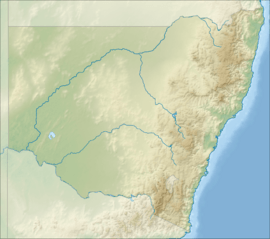Wallumatta Nature Reserve facts for kids
Quick facts for kids Wallumatta Nature ReserveNew South Wales |
|
|---|---|
|
IUCN Category Ia (Strict Nature Reserve)
|
|

|
|
| Nearest town or city | East Ryde, Sydney |
| Established | 1980s |
| Area | 6.195 hectares (15 acres) |
| Managing authorities | NSW National Parks & Wildlife Service |
| Website | Wallumatta Nature Reserve |
| See also | Protected areas of New South Wales |
Wallumatta Nature Reserve, also known as the Macquarie Hospital Bushland, is a special natural area in Sydney, Australia. It's about 6 hectares (15 acres) in size and is surrounded by homes in the suburb of East Ryde. This reserve is a very important part of Sydney's natural history.
Contents
What is Wallumatta Nature Reserve?
This reserve is a "nature reserve," which means it's a protected area where plants and animals can live safely. It's the biggest remaining piece of a special type of forest called Sydney Turpentine-Ironbark Forest. This forest is an endangered ecosystem, meaning it's at risk of disappearing forever. The ground here is made of two main types of rock: Ashfield Shale and Hawkesbury Sandstone.
The name "Wallumatta" comes from the Eora language, spoken by the Aboriginal people who lived here long ago. It means "snapper," which is a type of fish found in the local waters.
Plants and Animals You Might See
The forest is full of tall trees that form a canopy, like a green roof. The most common trees you'll find are:
You might also spot a grey box tree, which usually grows in drier parts of Sydney. Another interesting plant is the blueberry ash, which likes wetter, more fertile areas.
Many native animals call Wallumatta Nature Reserve home. Keep an eye out for:
- Brushtail possum
- Grey-headed flying fox (a type of bat)
- Blue-tongue lizard
- Red-bellied black snake
Unfortunately, some animals that don't belong here, like foxes, domestic dogs, and cats, can be a danger to the native wildlife.
Protecting the Reserve
Wallumatta Nature Reserve is used as a "demonstration site" to show how we can help nature recover. A lot of "bush regeneration" work happens here. This means people work hard to remove weeds (plants that don't belong and can harm native species) and help the original plants grow strong. This helps the whole ecosystem stay healthy.
This special area was once known as the Macquarie Hospital Bushland and was officially recognized as important in 1990. It's managed by the NSW National Parks & Wildlife Service, who work to keep it safe for everyone to enjoy and for nature to thrive.
See also
 In Spanish: Reserva natural de Wallumatta para niños
In Spanish: Reserva natural de Wallumatta para niños


